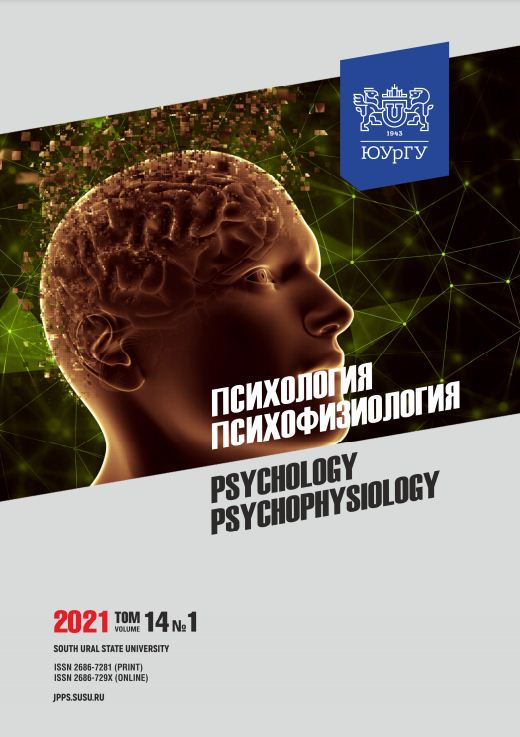RELATIONSHIP OF PERCEIVED FACIAL ASYMMETRY TO ATTRIBUTED PERSONALITY TRAITS
Abstract
Abstract. Although phrenology and physiognomy have been considered a pseudoscience, most people make consistent judgments based on faces. Though their knowledge may not be expressed in words, it involves stereotypes widespread across a given culture. Aim: to determine the relationships between perception of facial asymmetry and personality traits associated with stereotypical judgements. Materials and methods: 151 volunteers were recruited – 71% female (mean age 25.4 years, SD = 6.98) and 29% male (mean age 25.9 years, SD = 8.29). A new assessment method has been proposed: participants in addition to classifying 21 Caucasian male gray-scale facial images and their mirror images into one of three categories (symmetric, right asymmetric or left asymmetric) were asked to rate on a one to seven scale 19 polar opposite personality traits. Chi-squared test, ANOVA, independent t-tests, rank correlations were analyzed with SPSS Statistics Version 27. Results: Statistically significant differences were found among left asymmetry, right asymmetry, and symmetry classifications in the patterns of assessed personality traits; between the personality traits of the unaltered faces and their mirror images; faces judged as asymmetric and faces judged as symmetric; faces judged as asymmetric and symmetric by females; extreme right asymmetric faces and extreme left asymmetric faces. Significantly greater statistical differences were found for attributed personality traits of honest, calm, athletic, sociable, and distinctive. Conclusion: The detection that most of the socially desirable traits were found in the top five faces perceived as extremely right asymmetric rather than the top five extremely left asymmetric is most intriguing and warrants further research.
Downloads
References
2. Galton F. Composite Portraits. Nature. 1878; 18: 97–100.
3. Sackeim H., Gur R., Saucy M. Emotions are Expressed More Intensely on the Left Side of the Face. Science. 1978; 202 (4366): 434–436. DOI: 10.1126/science.705335
4. McGee A.M., Skinner M. Facial Asymmetry and the Attribution of Personality Traits. British Journal of Social Psychology. 1987; 26 (2): 181–184. DOI: 10.1111/j.2044-8309.1987.tb00778.x
5. Fink B., Neave N., Manning J.T. et al. Facial Symmetry and the “Big-Five” Personality Factors. Personality and Individual Differences. 2005; 39 (2): 523–529. DOI: 10.1016/j.paid.2005.02.002.
6. Alper S., Bayrak F., Yilmaz O. All the dark triad and some of the big five traits are visible in the face. Personality and Individual Differences. 2020; 168: 110350. DOI: 10.1016/j.paid.2020.110350
7. Kachur A., Osin E., Davydov D., et al. Assessing the Big Five personality traits using real-life static face images. Scientific Reports. 2020; 10: 8487. DOI: 10.1038/s41598-020-65358-6.
8. Kowner R. Facial Asymmetry and Attractiveness Judgement in Developmental Perspective. Journal of Experimental Psychology: Human Perception and Performance. 1996; 22 (3): 662–675. DOI: 10.1037/0096-1523.22.3.662.
9. Choi K.Y. Analysis of Facial Asymmetry. Archives of Craniofacial Surgery. 2015; 16 (1): 1–10. DOI:10.7181/acfs.2015.16.1.1.
10. Sinko K., Jagsch R., Drog C., et al. Facial esthetics and the assignment of personality traits before and after orthognathic surgery rated on video clips. PLoS One 2018; 13 (2): e0191718. DOI: 10.1371/journal.pone.0191718
11. Švegar D. What does facial symmetry reveal about health and personality? Polish Psychological Bulletin. 2016; 47 (3): 356–65. DOI: 10.1515/ppb-2016-0042.
12. Wilson J.P., Rule N.O. Advances in understanding the detectability of trustworthiness from the face: toward a taxonomy of a multifaceted construct. Current Directions in Psychological Science. 2017; 26 (4): 396–400. DOI: 10.1177/0963721416686211.
13. Cogsdill E.J., Todorov A.T., Spelke E.S., Banaji M. Inferring character from faces: a developmental study. Psychological Science. 2014; 25 (5): 1132–1139. DOI: 10.1177/0956797614523297
14. Hope D., Bates T., Penke L. et al. Fluctuating asymmetry and personality. Personality and Individual Differences. 2011. 50 (1): 49–52. DOI: 10.1016/j.paid.2010.08.020.
15. Harrison C., Binetti N., Coutrot A. et al. Personality Traits Do Not Predict How We Look at Faces. Perception. 2018; 47 (9): 976–984. DOI: 10.1177/0301006618788754
16. Keim R.G. The Puzzle of facial asymmetry. Journal of Clinical Orthodontics. 2018; 52 (6-7): 323. https://europepmc.org/article/ med/30048953
17. Veeranki S., Park J.H., Pruzansky D. et al. A Current Review of Asymmetry. Journal of Clinical Orthodontics. 2018; 52 (6-7); 325–341. https://pubmed.ncbi.nlm.nih.gov/30048954/
18. Bashour M. History and current concepts in the analysis of facial attractiveness. Plastic and Reconstructive Surgery. 2006; 118: 741–756. DOI: 10.1097/01.prs.0000233051.61512.65.
19. Malm I.J., Albathi M., Byrne P. et al. (2018) Facial Asymmetry Index: Validation and Applications in Various Smile Restoration Techniques. Facial Plastic Surgery & Aesthetic Medicine. 2018; 34 (4): 381–383. DOI: 10.1055/s-0038-1660836.
20. Holtzman N.S., Augustine A.A., Senne A.L. Are pro-social socially aversive people more physically symmetrical? Symmetry in relation to over 200 personality variables. Journal of Research in Personality. 2011; 45: 687–691. DOI: 10.1016/j.jrp.2011.08.003.
21. Mugnier J., Ibrahim B., Bouletreau P., Sigaux N. The influence of orthognathic surgery on the perception of personality traits: A scoping review. International Journal of Oral and Maxillofacial Surgery. 2020; 49 (10): 1294–1302. DOI: 10.1016/j.ijom.2020.03.017
References on translit
-Copyright (c) 2021 Psychology. Psychophysiology

This work is licensed under a Creative Commons Attribution-NonCommercial-NoDerivatives 4.0 International License.



